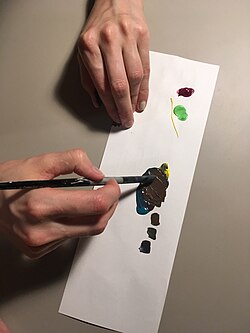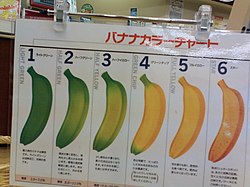180:
85:. Because color blindness is a symptom of several genetic and acquired conditions, the severity can range drastically from monochromacy (no color vision) to anomalous trichromacy (can be as mild as being indistinguishable from normal color vision). Congenital (genetic) color blindness causes difficulty in all four kinds of color tasks. However, cerebral color blindness may cause issues only in some types of color tasks, and other conditions that do not affect color vision can still affect color vision tasks (e.g.
20:
232:
98:
280:
63:
Earlier classification of color tasks did not attempt to be comprehensive, and mainly differentiated between color matching/ordering, pseudoisochromatic plates and color-naming. In Cole's definitions, the latter would be denotative color tasks and the others would be comparative color tasks.
306:). Aesthetic color tasks are necessary in architecture, interior decoration, graphic design, advertising, matching clothes, abstract art, etc. Aesthetic tasks are not generally tested for since aesthetic tasks are highly subjective.
191:
Connotative color tasks require the subject to infer implicit information from a color. In addition to color vision, connotative color tasks require either cultural or natural knowledge to interpret the color's meaning.
179:
128:
also requires comparison of adjacent colors to be able to arrange them in a meaningful spectrum. In addition to being able to distinguish two colors, arrangement tests also require measuring
251:
or description. Anything that requires this conversion, either from color to description (color naming) or vice versa, is a denotative color task. Denotative color tasks involve both
34:
are tasks that involve the recognition of colors. Color tasks can be classified according to how the color is interpreted. Cole describes four categories of color tasks:
562:
Geddes, Connor; Flatla, David R.; Tigwell, Garreth W.; Peiris, Roshan L (29 April 2022). "Improving Colour
Patterns to Assist People with Colour Vision Deficiency".
267:
can also lead to a failure to perform denotative color tasks even when color vision is normal. Some color vision tests comprise denotative tasks, such as
132:
and decision making based on this parameter. Despite the increased complexity of this task, they were not differentiated by Cole, though were by others.
121:
require a direct comparison (and therefore discrimination) of foreground and background colors to be able to read the embedded number/character.
125:
579:
494:
Turner, William D.; DeSilva, Harry R. (October 1934). "The
Perception of Color and Contour: An Unusual Abnormal Case".
451:
Heywood, C.A.; Kentridge, R.W.; Cowey, A. (September 1998). "Cortical Color
Blindness is Not "Blindsight for Color"".
118:
151:
614:
109:
Comparative color tasks require a subject to differentiate two colors. Simple examples include many
585:
511:
476:
268:
203:). Examples of connotative color tasks based on natural meaning are interpretation of skin tone (
110:
378:
Geschwind, N.; Fusillo, M. (1 August 1966). "Color-Naming
Defects in Association With Alexia".
105:
color task, namely distinguishing the green foreground (the letter "W") from the red background
575:
468:
433:
395:
299:
619:
567:
542:
503:
460:
425:
387:
357:
247:
In order to communicate colors, we generally must first convert the color into a meaningful
138:
is the "purest" tasks that relies almost solely on color perception without interference of
129:
59:– When colors look nice – or convey an emotional response – but don’t carry explicit meaning
416:
Denckla, Martha Bridge (June 1972). "Performance on Color Tasks in
Kindergarten Children".
199:, which require not only recognizing the color, but interpreting the meaning of the color (
295:
200:
143:
78:
73:
391:
609:
361:
283:
86:
547:
530:
429:
154:
can affect the other color tasks while leaving the comparative color tasks untouched.
603:
589:
320:
315:
196:
114:
480:
325:
264:
252:
82:
53:– When identifying colors, for example by name, such as “where is the yellow ball?”
19:
294:
Aesthetic color tasks require aesthetic judgments of colors, usually in terms of
303:
256:
236:
248:
231:
139:
571:
464:
302:. Alternatively colors can be selected for their evocative qualities (e.g.
279:
97:
472:
437:
399:
531:"Impaired Performance on Color Tasks in Patients with Hemispheric Damage"
220:
216:
204:
113:, which are specifically modeled as comparative tasks. For example, the
515:
260:
208:
212:
195:
An example of a connotative color task based on cultural meaning are
147:
507:
183:
Banana ripeness scale; identifying the ripeness through color is a
41:– When multiple colors must be compared, such as with mixing paint
348:
Cole, Barry L (1972). "The handicap of abnormal colour vision".
47:– When colors are given an implicit meaning, such as red = stop
298:, where color combinations can be selected to be pleasing or
150:. Sometimes, color blindness derived from brain damage (e.g.
271:, which require the subject to name the colors of lights.
564:
CHI Conference on Human
Factors in Computing Systems
157:Other examples of comparative color tasks include:
81:(or color vision deficiency) is a defect of normal
23:Mixing paint to match a desired color is a type of
101:Pseudoisochromatic plate; solving it requires a
215:, etc.) and interpretation of food edibility (
8:
161:Distinguishing red fruits from green foliage
373:
371:
16:Task that involves the recognition of color
546:
411:
409:
529:De Renzi, E.; Spinnler, H. (June 1967).
343:
341:
278:
230:
178:
96:
18:
337:
7:
392:10.1001/archneur.1966.00470140027004
350:Clinical and Experimental Optometry
170:Painting/drawing realistic subjects
496:The American Journal of Psychology
362:10.1111/j.1444-0938.1972.tb06271.x
14:
167:Reading colored data with legends
124:Arrangement tests such as the
1:
548:10.1016/S0010-9452(67)80012-1
430:10.1016/S0010-9452(72)80017-0
453:Consciousness and Cognition
235:Describing colors by their
636:
71:
119:Pseudoisochromatic plates
572:10.1145/3491102.3502024
465:10.1006/ccog.1998.0364
291:
244:
188:
152:cerebral achromatopsia
106:
28:
380:Archives of Neurology
282:
234:
182:
100:
22:
286:requires completing
304:warmth or coolness
292:
245:
189:
111:Color vision tests
107:
29:
566:. pp. 1–17.
627:
594:
593:
559:
553:
552:
550:
526:
520:
519:
491:
485:
484:
448:
442:
441:
413:
404:
403:
375:
366:
365:
345:
253:color perception
130:color difference
635:
634:
630:
629:
628:
626:
625:
624:
600:
599:
598:
597:
582:
561:
560:
556:
528:
527:
523:
508:10.2307/1415493
493:
492:
488:
450:
449:
445:
415:
414:
407:
377:
376:
369:
347:
346:
339:
334:
312:
277:
229:
177:
126:Farnsworth D-15
95:
79:Color blindness
76:
74:color blindness
70:
68:Color blindness
17:
12:
11:
5:
633:
631:
623:
622:
617:
612:
602:
601:
596:
595:
580:
554:
541:(2): 194–217.
521:
486:
459:(3): 410–423.
443:
424:(2): 177–190.
405:
386:(2): 137–146.
367:
356:(8): 304–310.
336:
335:
333:
330:
329:
328:
323:
318:
311:
308:
284:Fashion Design
276:
273:
228:
225:
201:red means stop
197:traffic lights
176:
173:
172:
171:
168:
165:
162:
94:
91:
72:Main article:
69:
66:
61:
60:
54:
48:
42:
15:
13:
10:
9:
6:
4:
3:
2:
632:
621:
618:
616:
613:
611:
608:
607:
605:
591:
587:
583:
581:9781450391573
577:
573:
569:
565:
558:
555:
549:
544:
540:
536:
532:
525:
522:
517:
513:
509:
505:
501:
497:
490:
487:
482:
478:
474:
470:
466:
462:
458:
454:
447:
444:
439:
435:
431:
427:
423:
419:
412:
410:
406:
401:
397:
393:
389:
385:
381:
374:
372:
368:
363:
359:
355:
351:
344:
342:
338:
331:
327:
324:
322:
321:Color agnosia
319:
317:
316:Achromatopsia
314:
313:
309:
307:
305:
301:
297:
296:color harmony
289:
285:
281:
274:
272:
270:
269:lantern tests
266:
262:
258:
254:
250:
242:
238:
233:
226:
224:
222:
218:
214:
210:
206:
202:
198:
193:
186:
181:
174:
169:
166:
163:
160:
159:
158:
155:
153:
149:
145:
141:
137:
133:
131:
127:
122:
120:
116:
115:Ishihara test
112:
104:
99:
92:
90:
88:
84:
80:
75:
67:
65:
58:
55:
52:
49:
46:
43:
40:
37:
36:
35:
33:
26:
21:
615:Color vision
563:
557:
538:
534:
524:
499:
495:
489:
456:
452:
446:
421:
417:
383:
379:
353:
349:
326:Color anomia
293:
290:color tasks.
287:
265:color anomia
246:
240:
194:
190:
184:
164:Mixing paint
156:
135:
134:
123:
108:
102:
83:color vision
77:
62:
56:
50:
44:
38:
31:
30:
24:
257:linguistics
237:color terms
187:color task.
185:connotative
175:Connotative
140:linguistics
136:Comparative
103:comparative
93:Comparative
45:Connotative
39:Comparative
32:Color tasks
25:comparative
604:Categories
502:(4): 537.
332:References
300:flattering
249:color term
243:color task
241:denotative
227:Denotative
117:and other
51:Denotative
27:color task
590:248419679
288:aesthetic
275:Aesthetic
223:, etc.).
57:Aesthetic
310:See also
221:doneness
217:ripeness
205:blushing
620:Agnosia
516:1415493
481:4112408
473:9787052
438:5043792
400:5945970
261:Aphasia
209:sunburn
144:culture
588:
578:
535:Cortex
514:
479:
471:
436:
418:Cortex
398:
213:pallor
148:memory
87:Anomia
610:Color
586:S2CID
512:JSTOR
477:S2CID
239:is a
576:ISBN
469:PMID
434:PMID
396:PMID
255:and
568:doi
543:doi
504:doi
461:doi
426:doi
388:doi
358:doi
263:or
146:or
89:).
606::
584:.
574:.
537:.
533:.
510:.
500:46
498:.
475:.
467:.
455:.
432:.
420:.
408:^
394:.
384:15
382:.
370:^
354:55
352:.
340:^
259:.
219:,
211:,
207:,
142:,
592:.
570::
551:.
545::
539:3
518:.
506::
483:.
463::
457:7
440:.
428::
422:8
402:.
390::
364:.
360::
Text is available under the Creative Commons Attribution-ShareAlike License. Additional terms may apply.



